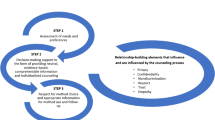Abstract
Objective The aim of this study was to examine information sources used by women who use hormonal contraceptives (HCs), and how information source affected women’s attitudes and perceptions in 2001 and 2007. Setting The questionnaires were distributed from university pharmacies in 12 large cities across Finland. Method The data were collected with two questionnaire surveys among women who used hormonal contraceptives in 2001 and 2007. In the 2001 survey the response rate was 53% (n = 264) and in the 2007 survey 55% (n = 436). Results The number of respondents who considered professional information sources the most important information sources was markedly bigger in 2007 than in 2001 (P = 0.005). The most common source of information concerning the benefits of hormonal contraceptives was a physician (2001: 43%, 2007: 53%). The most common source of information concerning the risks of hormonal contraceptives was friends and relatives (43%) in 2001 and physician in 2007 (35%). Only a few percent of the respondents considered a pharmacy the most important information source both the 2001 and 2007 surveys. Conclusion The importance of health care professionals as sources of information concerning hormonal contraceptives has increased. However, role of pharmacists as information source was surprisingly small. Women who use hormonal contraceptives need more information from professional sources to alleviate possible fears associated with use.




Similar content being viewed by others
References
Kosunen EA, Sihvo S, Nikula M, Hemminki E. Birth control. In: Koponen P, Luoto R, editors. Reproductive health in Finland. The Health 2000 survey. B/2004 ed. Helsinki: National Public Health Institute; 2004. ISBN 951-740-422-0.
Koponen P, Lindbohm M-L, Sihvo S. Pregnancies, deliveries, miscarriages and abortions. In: Koponen P, Luoto R, editors. Reproductive health in Finland. The Health 2000 survey. B/2004 ed. Helsinki: National Public Health Institute; 2004. ISBN 951-740-422-0.
National Agency for medicines and social Insurance Institution. The Finnish Statistics of Medicine 1995–2005. Helsinki: Edita Prima Oy. ISSN 0786-2180.
Nomesco. Medicines consumption in the Nordic countries 1999–2003. http://nomesco-eng.nom-nos.dk/default.asp?side=204. Accessed 10 Sep 2009.
National Research and Development Centre for Welfare and Health (STAKES). Reproduction. http://www.stakes.fi/EN/Tilastot/statisticsbytopic/index.htm. Accessed 10 Sep 2009.
Kontula O, Meriläinen H. In: Finnish: Koulun seksuaalikasvatus 2000-luvun Suomessa. Helsinki: Väestöliitto (The Family Federation); 2007. ISBN 978-951-9450-69-8.
Jones RK, Darroch JE, Henshaw SK. Contraceptive use among U.S. women having abortions in 2000–2001. Perspect Sex Reprod Health. 2002;34:294–303.
Tiihonen MJ, Leppänen H-M, Heikkinen A-M, Ahonen RS. Hormonal contraceptive users’ self-reported benefits, adverse reactions and fears in 2001 and 2007. Patient. 2008;1:173–80.
Halpern V, Grimes DA, Lopez LM, Gallo MF. Strategies to improve adherence and acceptability of hormonal methods of contraception. Cochrane Database of Syst Rev. 2008;2:CD004317. doi:10.1002/14651858.CD004317.pub2.
Little P, Griffin S, Kelly J, Dickson N, Sadler C. Effect of educational leaflets and questions on knowledge of contraception in women taking the combined contraceptive pill: randomised controlled trial. Br Med J. 1998;316:1948–52.
Vainio KK, Airaksinen MSA, Hyykky TT, Enlund KH. Effect of therapeutic class on counseling in community pharmacies. Ann Pharmacother. 2002;36:781–6.
Aslanpour Z, Smith FJ. Oral councelling on dispensed medication: a survey of its extent and associated factors in random sample of community pharmacies. Int J Pharm Pract. 1997;5:57–63.
Vainio KK, Airaksinen MSA, Väisänen T, Enlund H. Assessing the importance of community pharmacies as providers of drug information. J Appl Ther Res. 2004;5:24–8.
National Agency for medicines and social Insurance Institution. The Finnish Statistics of Medicine 2005. Helsinki: Edita Prima Oy; 2006. ISSN 0786-2180.
Sihvo S, Ahonen R, Mikander H, Hemminki E. Self-medication with vaginal antifungal drugs: physicians’ experiences and women’s utilization patterns. Fam Pract. 2000;17:145–9.
Tiihonen MJ, Heikkinen A-M, Ahonen RS. Do Finnish women using hormone replacement therapy need more information about risks. Pharm World Sci. 2007;29:635–40.
Leppänen H-M. Ehkäisypillereiden käytön edut ja haitat—tutkimus e-pillereiden käyttäjien kokemuksista [The benefits and adverse reactions of oral contraceptive users—users’ experiences]. Master’s thesis (unpublished), Department of Social Pharmacy, University of Kuopio; 2002.
Sundby J, Svanemyr J, Maehre T. Avoiding unwanted pregnancy—the role of communication, information and knowledge in the use of contraception among young Norwegian women. Patient Educ Couns. 1999;38:11–9.
Stewart DC, George J, Bond CM, Cunningham IT, Diack HL, McCaig DJ. Exploring patients’ perspectives of pharmacist supplementary prescribing in Scotland. Pharm World Sci. 2008;30:892–7.
Collaborative Group On Epidemiological Studies of Ovarian Cancer, Beral V, Doll R, Hermon C, Peto R, Reeves G. Ovarian cancer and oral contraceptives: collaborative reanalysis of data from 45 epidemiological studies including 23,257 women with ovarian cancer and 87,303 controls. Lancet. 2008;371:303–14.
de Boer MJ, Versteegen GJ, van Wijhe M. Patients’ use of the Internet for pain-related medical information. Patient Educ Couns. 2007;68:86–97.
Sihvo S, Hemminki E. Self-medication of dyspepsia: how appropriate is it? Scand J Gastroenterol. 1997;32:855–61.
Acknowledgements
We wish to thank Ms Paula Räsänen and Ms Seija Pirhonen for their help in our research.
Funding
University of Kuopio provided the funding.
Conflicts of interest
None declared.
Author information
Authors and Affiliations
Corresponding author
Rights and permissions
About this article
Cite this article
Tiihonen, M., Heikkinen, AM., Leppänen, HM. et al. Information sources used by women in Finland who use hormonal contraceptives. Pharm World Sci 32, 66–72 (2010). https://doi.org/10.1007/s11096-009-9344-6
Received:
Accepted:
Published:
Issue Date:
DOI: https://doi.org/10.1007/s11096-009-9344-6



